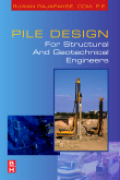
All objects and structures transfer their load either directly or indirectly to the earth. The capacity of the earth to support such loads depends on the strength and stability of the supporting soil or rock materials. Pile foundations are the part of a structure used to carry and transfer the load of the structure to the bearing ground located at some depth below ground surface. There are many texts on pile foundations. Generally, these books are complicated anddifficult to understand. Easy to use and understand, this book covers virtually every subject concerning pile design, featuring techniques that do not appear in other books on the subject. The book contains design methods with real life examples on pin piles, bater piles, concrete piles, steel piles, timber piles, auger cast piles, underpinning design, seismic pile design, negative skinfriction and design of Bitumen coated piles for negative skin friction and many other subjects.The book is packed with design examples, case studies and after construction scenarios are presented for the reader's benefits. This book enables the reader to come away with a complete and comprehensive understanding of the issues related to the design, installation and construction of piles.It is a handy guide for engineers preparing the professional engineer (PE) exam. It includes numerous design examples for sandy soils, clay soils, and seismic loadings. It includes methodologies and case studies for different pile types.
- ISBN: 978-0-7506-8763-8
- Editorial: Butterworth Heinemann - Elsevier
- Encuadernacion: Rústica
- Páginas: 444
- Fecha Publicación: 01/12/2008
- Nº Volúmenes: 1
- Idioma: Inglés
